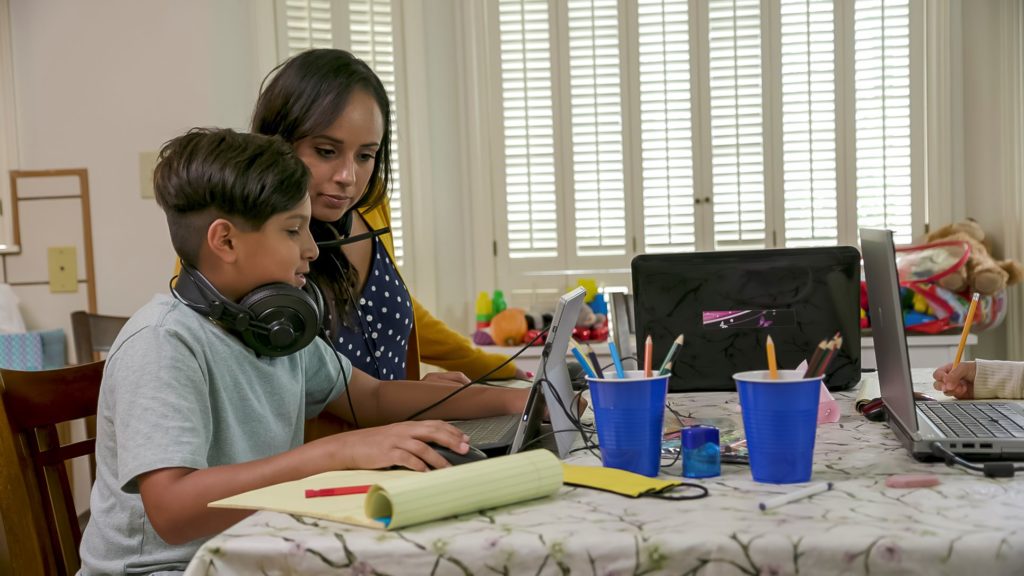
Kami Lee is a client implementation specialist at Procare Solutions, a job she started in June. And for more than a year before being hired, she was part of the large number of women who left the workforce due to the coronavirus pandemic.
Her previous job was as a high school art teacher. When the school shifted to remote learning in March of 2020, she pulled her 4-year-old son out of his daycare.
Her husband was working from home and they thought they could manage it. But she ended up leaving her teaching job. And despite being a teacher, it was tough to teach her son.
“It’s very different to create structure and standards with your child,” said Kami, who is pregnant with her second child.
Many days, her goal was to make sure he got outside time. And if that happened, she counted it as a successful day. There simply wasn’t time to do things that a teacher does, such as build curriculum, she said.
Her son was out of child care for 14 months. And when Kami and her husband eventually sought a daycare for him, it was hard to find a spot due to a shortage of child care staff.
Many child care workers are leaving their jobs to care for their own children.
“There are super long waiting lists,” said Kami, who lives in a suburb of Denver.
Kami almost secured him a spot at a daycare that’s a six-minute drive from her house. But a week before he was supposed to start, she learned his spot was gone because there wasn’t staff to care for him.
Now she and her husband drive 20 minutes to a child care center. She’s grateful they found a place he can go while they work.
“It’s very different to create structure and standards with your child,” says Kami Lee, a former teacher who left her job to care for her son last year. She now works as a client implementation specialist at Procare Solutions.
We’re in the Midst of a ‘She-cession’
Kami was a part of what’s being called a “she-cession.”
That’s the name given to the exodus of women from the workforce spurred by the COVID-19 pandemic, which continues to complicate the lives of families and impact child care centers.
During the first 10 months of the coronavirus pandemic, more than 2.3 million women left the labor force, according to the National Women’s Law Center.
That includes 611,000 job losses among 23.5 million working mothers, the researchers estimated. And the losses were greatest in states that had child care center closures in the spring of last year.
“Study after study has shown that in response to school, child care and camp closings, as well as reduced hours and reduced class sizes, significantly more women than men have reduced their work hours, left work to care for children, and spent more time on education and household tasks,” according to findings from a report issued by The Century Foundation and the Center for American Progress.
Let’s take a look at what that means for families and your daycare.
How the Pandemic Affected Working Parents
The coronavirus has caused drastic shifts in the workforce and lifestyles. With many workplaces, child care centers and schools closed or under work-from-home arrangements, and with family incomes often shrinking, parents had to find new ways to ensure kids were supervised during the day.
Parents’ ability to access child care was affected by the COVID-19 pandemic in three major ways:
- Changing Child Care Arrangements: In 2020, almost half of child care centers were completely closed for at least some time, and more were under capacity restrictions or other legal limitations. In the face of these barriers to child care access, parents had to find other arrangements when they needed child care. Some estimates show 10% of centers closed for good.
- Kids Staying Home with Family and Friends: While the pandemic at times meant kids couldn’t attend child care or school, many adults were also at home, whether due to lost jobs or remote work. For these adults, the pandemic thrust them into a new role of providing full-time child care for their own children or those of friends or family — sometimes, precariously balancing child care with working from home.
- Parents Leaving the Workforce: During the pandemic, some parents of young children have left the workforce entirely, as lost jobs and lack of access to child care leave them with few other options.
Mothers with young children arranged reductions in their work hours that are four to five times greater than the reductions arranged by fathers.
And often those reductions meant pulling their children from daycare, or perhaps reducing the hours each week that kids are in care.
The Work-From-Home Effect

A recent Catalyst survey found that women with child care responsibilities who have remote-work access are 32% less likely to report intending to leave their jobs than women with child care responsibilities who do not have remote-work access.
Not being allowed to work from home is one reason women leave the workforce. And for those who do have that choice, it means rethinking their child care.
Because of the flexibility of working from home, some parents are opting to pull their kids from before care and after care programs.
Some school districts are responding by giving parents as much flexibility as they can. For example, the Littleton and Cherry Creek districts in suburban Denver both give parents the option to schedule care the night before they need it, as well as in advance, so they’re not paying for a week of care if they only need a couple days.
Child care centers can respond in similar fashion by offering parents more options. Ideas include offering part-time care or even shorter days at a reduced rate to accommodate parents who can do later drop-offs and earlier pick-ups.
Looking Forward
Many companies that had intended to require employees to return to the office this fall have pushed back that date due to the spread of the Delta variant.
As more companies start to mandate that workers come into offices, more women who have been doing their jobs remotely could opt to leave the workforce if not given the option to continue working from home.
On the flip side, the predicted coming availability of the COVID-19 vaccine for younger children might spur more to return.
Some women left their jobs to focus on helping their children learn virtually. Sometimes that choice was because of a lack of in-person learning. Other parents, particularly those with children at a high risk of becoming seriously ill from the coronavirus, opted to keep their kids home from schools or child care centers to avoid becoming infected.
The COVID-19 vaccine could be authorized for children ages 5 to 11 by the end of October. When that vaccine is approved, it’s expected that some women who had been hesitant to put their kids in care will be willing to send their vaccinated children back to school — leaving the door open for them to return to the workforce.
The trend of women leaving could slow as more child care centers regain pre-pandemic attendance levels, which could lead to the ability to hire more staff and take in more kids.
Procare Solutions continues to analyze data showing the impact of COVID-19 on trends in attendance as child care centers begin to return to full capacity.
Our most recent report, which you can find here, shows the average capacity nationwide is at 71% of pre-pandemic levels. (In April of 2020, that number was just 30%.)
Stay tuned for more Procare blogs and information on how shifting work patterns are changing the face of child care!



